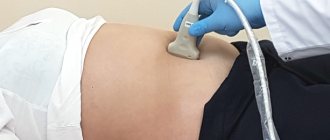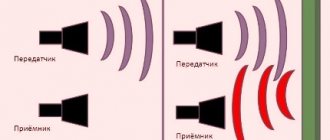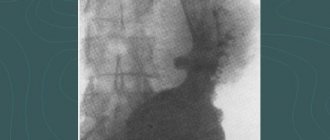Main advantages of ultrasound
- high reliability,
- versatility,
- painlessness,
- safety,
- wide availability,
- no side effects,
- possibility of repeated research,
- almost complete absence of contraindications.
- About the service
- Indications for use
- Preparation
About the service Ultrasound of the abdominal cavity, kidneys and retroperitoneal space is a modern diagnostic method that helps identify tumors, cysts, polyps, stones (gallstones, kidney stones), inflammatory diseases, degenerative-dystrophic changes in organs, anatomical disorders, injuries or other pathologies with a high degree of reliability, information content of the data.
Ultrasound examinations at the Tibet Clinic are distinguished by the fact that they allow not only to diagnose diseases, but also to carry out their optimal treatment using oriental medicine methods - without side effects, pills, surgeries or hormones.
Diagnostics of the abdominal cavity, kidneys, retroperitoneal space in “Tibet” is a guarantee of high quality examination, the basis for successful treatment of diseases. Ultrasound in Moscow can be done in many places, but only in “Tibet” is it part of oriental medicine.
Prices for ultrasound
| Abdominal cavity and retroperitoneal space | |
| Ultrasound examination of the abdominal organs (comprehensive) | 2500 |
| Ultrasound examination of the liver | 1200 |
| Ultrasound examination of the gallbladder and ducts | 1000 |
| Ultrasound examination of the gallbladder with determination of its contractility | 1500 |
| Ultrasound examination of the pancreas | 1200 |
| Ultrasound examination of the spleen | 950 |
| Ultrasound examination of the bladder | 800 |
| Ultrasound examination of the kidneys and adrenal glands | 1200 |
* see all types of studies and prices
Indications for ultrasound
The main indications for an ultrasound of the abdominal cavity: flatulence (increased gas production), bitterness in the mouth, nausea, vomiting, pain in the right hypochondrium and abdominal area (epigastric region), jaundice (yellowing of the skin, sclera of the eyes).
It should be done in case of persistent indigestion, chronic constipation or diarrhea, loss of appetite, sudden change in body weight (increase or decrease). Ultrasound of the abdominal organs is performed if there is a suspicion of oncological diseases (cancer of the liver, pancreas), metastases, benign neoplasms (tumors, cysts, adenomas), abscess, pancreatitis, hepatitis, hepatosis, cirrhosis of the liver, cholelithiasis, cholecystitis, ascites, biliary dyskinesia paths (including bending, constriction of the gallbladder).
An abdominal ultrasound is usually performed in a child who complains of pain in the abdomen, lower back (lower back) or girdle pain.
Ultrasound of the retroperitoneal space is prescribed for girdle pain, the presence of blood in the urine, suspected urolithiasis, tumors, pyelonephritis, glomerulonephritis, nephropathy, nephrosclerosis, diseases of the adrenal glands, pathology of blood vessels, lymph nodes.
Ultrasound of the retroperitoneal space allows you to see not only neoplasms, traumatic injuries or inflammatory processes, but also the condition of the blood vessels (the size of the lumen, the presence of atherosclerosis, blood clots, the location of the vessels), as well as an increase in regional lymph nodes.
Preparation
Interpretation of abdominal ultrasound results
Decoding the results obtained during an ultrasound of the abdominal cavity is a set of digital values and characteristics of the ultrasound reflected from a particular organ. This information is reflected in the study protocol. With it, the patient turns to the attending physician, who will make an accurate diagnosis. However, before visiting a doctor, you can independently understand all these numbers and have a rough idea of the state of your health.
To do this, you need to compare the ultrasound results with indicators of normality and deviations. They are different for each organ.
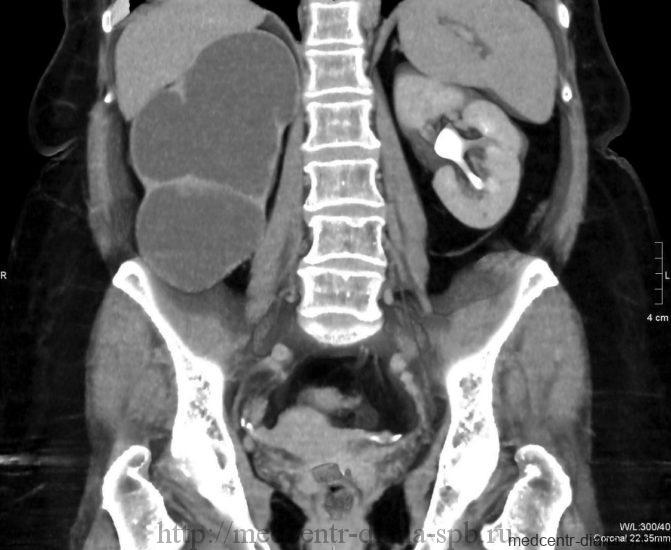
Interpretation of abdominal ultrasound: liver
| Normal indicators | Deviations |
| Right lobe: length - 10 cm, thickness - up to 7 cm; Left lobe: length - 5 cm, thickness - 12-13 cm: Oblique vertical size: up to 15 cm. | Rounded edge, increased echo density, increased size, dilation of the splenic and portal veins, uneven contours, free fluid in the abdominal cavity. |
Explanation:
- If there is a rounding of the edges with an increase in the size of the liver, this may be a sign of stagnation of harmful substances in the liver. This happens against the background of heart disease.
- The presence of abscesses, tumors and cysts is indicated by areas of the organ with a disturbed echostructure.
- Increased echo density is observed with fatty hepatosis, which is also accompanied by compaction of the organ and the inability to visualize blood vessels.
- Liver cirrhosis is characterized by uneven contours, an increase in the size of the organ and dilation of the portal and splenic veins.
Interpretation of ultrasound: gallbladder
| Norm | Deviations |
| Pear-shaped or cylindrical shape of the organ; Width - 3-5 cm, length - up to 10 cm; Wall thickness - up to 4 mm; Volume - 30-70 cm³; Absence of formations in the lumen. | Wall thickening (“double contour”), fluid around the gallbladder, acoustic shadow, uneven contours, dilation of the bile ducts. |
Explanation:
- An acoustic shadow on the monitor indicates the presence of a tumor or stones in the gallbladder. This can be determined by the nature of the shadow.
- Signs of acute cholecystitis are: thickening of the walls, changes in size both up and down. And the presence of fluid means the development of peritonitis and the need for surgical intervention.
- With chronic cholecystitis, the contours of the bladder will be clear and dense.
- A sign such as dilatation of the bile ducts indicates that the free flow of bile is blocked by a stone.
Bile ducts
| Norm | Deviations |
| Common duct diameter: 6-8 mm; The hepatic ducts are not dilated inside. Pancreas: Head length - 35 mm, body - up to 25 mm, tail - 30 mm; Smooth contours; Homogeneous echostructure; Echogenicity is within normal limits; Lack of education. | Change in echo density; The Wirsung duct is dilated; Uneven contours; Displacement of the aorta. |
Explanation:
- Low echo density may be a sign of acute pancreatitis.
- If echo density increases, cancer or a chronic form of pancreatitis occurs.
- Signs such as uneven contours of the pancreas and increased size also indicate a malignant tumor.
Ultrasound interpretation: spleen
| Norm | Deviations |
| Length - about 11 cm, width - 4-5 cm; Longitudinal sectional area: up to 40 cm²; Homogeneous structure; Splenic index: up to 20 cm²; Splenic vein at the hilum | Densified organ tissue, increased size, |
Explanation:
- Dense splenic tissue is noted during a splenic infarction, when a certain area dies due to injury or thrombosis.
- On an ultrasound, you can see a rupture of the spleen with an increased size, which is also caused by injuries or bruises.
Interpretation of ultrasound of hollow organs - kidneys and gastrointestinal organs (stomach, intestines)
| Norm | Deviations |
| Buds: Width - 5-6 cm, length - up to 11 cm, thickness - up to 5 cm; The pelvis is not dilated; The thickness of the kidney parenchyma is up to 23 mm; Absence of foreign structures in the lumen of the ureters | Fluid accumulation, lesions |
Ultrasound of the gastrointestinal tract is performed to determine possible damage to their structure. The accumulation of fluid near the organs indicates deviations from the norm, which are identified through additional examinations. The stomach and intestines are not necessarily examined. Ultrasound of these organs may be prescribed by the attending physician for special indications.
Interpretation of ultrasound lymphatic structures in the abdominal cavity
| Norm | Deviations |
| Not rendered | Increase in size |
If they are enlarged, then there is a suspicion of an infection of the abdominal cavity, a malignant tumor, or the presence of tumor metastases in nearby organs.
Preparing for an ultrasound
To maximize the reliability of survey data, it is important how to prepare for it.
There are several standard rules and recommendations for this. For three days before diagnosis, it is necessary to exclude from the diet foods that cause increased gas formation, including brown bread, white yeast bread, baked goods, milk, legumes (beans, peas, beans), raw vegetables, fruits, and fatty meats. You should follow a regimen of fractional meals - 4-5 meals per day in small portions.
Before the examination, you can drink water up to 1.5-2 liters per day, but carbonated drinks, beer, fruit and vegetable juices should be excluded. Yeast bread should be replaced with yeast-free bread. You can eat low-fat cheese, soft-boiled eggs, as well as steamed, boiled or baked foods - lean poultry, fish, beef, buckwheat or oatmeal.
Preparation for an abdominal ultrasound may include taking enzymes (mezim, festal, etc.) to improve digestion, espumisan, enterosgel as prescribed by a doctor.
On the eve of the study, you should limit yourself to a light dinner. After 20 hours, eating is not advisable. If you are constipated, you should take a laxative. Ultrasound of the abdominal cavity and retroperitoneal space is performed on an empty stomach, so you should skip breakfast.
If the diagnosis is carried out after three o'clock in the afternoon, you should not eat food less than 8 hours before (a light breakfast is possible, but no later than 11 o'clock in the morning). Before the examination, you can only drink water, a little and at least 2 hours before. It is advisable to take 5-10 tablets of activated carbon two hours before the test. You should refrain from smoking, lollipops, and chewing gum.
In case of increased gas formation (flatulence), it is recommended to do a cleansing enema in the morning. The presence of air in the intestines interferes with obtaining reliable data, so colonoscopy and gastroscopy cannot be performed before the study.
If you plan to perform an ultrasound of the abdominal cavity and kidneys to diagnose the bladder, you should drink up to 1 liter of water before the examination. This is necessary to keep the bladder full.
Go Take the test and get a BONUS - a discount on treatment in our clinic Take the test
How is an ultrasound examination performed?
Ultrasound of the abdominal cavity and retroperitoneal space at the Tibet clinic does not take much time. Typically, the duration of the examination does not exceed 30-40 minutes. This is a completely painless, safe and completely comfortable procedure.
The examination is carried out in a lying position on a couch. The patient lies on his back, opening the abdominal area. The sensor is installed on the examination area (a special gel is first applied to the skin). During the scan, the doctor sees an image of the internal organs on the monitor. The sensor is moved manually over the surface of the body, and the patient may need to turn on his side or stomach. After the examination is completed, the gel is removed from the skin with napkins. Immediately after this, you can return to normal life.
The price of diagnostics at the Tibet clinic does not include any additional costs.
How is an MRI of the retroperitoneum done?
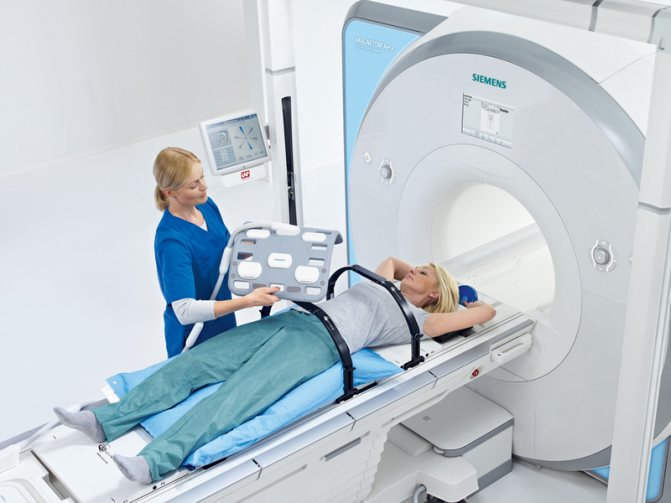
The diagnostic procedure includes several stages:
- preparation of medical documentation and questionnaires to identify contraindications;
- depositing items with paramagnetic properties - cell phones, payment cards, coins, keys, metal jewelry, etc.;
- placing the patient on the tomograph table; to prevent blurring on the films (due to involuntary movements), the limbs are fixed with bolsters and belts;
- scanning the area of interest, if contrast is required, the enhancer drug is administered intravenously after a series of native images;
- description and presentation of results.
MRI of the retroperitoneum is an absolutely painless procedure; the only inconvenience is technical noise, which can be dealt with using headphones. The patient's condition is monitored by medical staff from an adjacent room through a window. Communication takes place via speakerphone.
Ultrasound examination device
To carry out diagnostics, the Tibet clinic uses the latest device from Samsung Medison - the SonoAce R5 ultrasound scanner. The SonoAce R5 multifunctional scanner is an innovative development in the global production of medical equipment. Compared to the previous generation of ultrasound scanners, this device has a number of important advantages:
- advanced diagnostic capabilities,
- information content is 20% higher,
- higher data reliability,
- high resolution, increased clarity, detailed images.
Special options allow you to obtain higher quality images at any ultrasound penetration depth. Thanks to faster scanning speeds, ultrasound examinations take less time. The ability to combine ultrasonic information from different frequency bands minimizes the risk of false information and eliminates interference. The presence of color Doppler allows you to study in detail and reliably the nature of blood flow in the area of study.
SonoAce R5 allows you to conduct ultrasound examinations of all tissues, including hard-to-see tissues (tumors, etc.) and obtain contrast images of organs and tissues in people with normal or overweight.
The multifunctional ultrasound scanner SonoAce R5 is used for high-quality ultrasound of the abdominal cavity and retroperitoneal space, pelvis, kidneys, mammary glands and other types of diagnostics. Thanks to technological innovation and design excellence, SonoAce R5 has proven itself exceptionally well in urology, gynecology, mammology, and abdominal studies.
Who performs the ultrasound
At the Tibet clinic, ultrasound of the abdominal cavity and retroperitoneal space is performed by a highly qualified ultrasound diagnostics doctor, Maria Aleksandrovna Vasilyeva. Her exceptional professionalism and extensive experience are a guarantee of the high quality of the examination, the reliability of the data obtained and the correctness of the diagnosis.
How to use class=”aligncenter” width=”992″ height=”247″[/img]
or call +7 Moscow
Free consultation Survey, examination, pulse diagnostics from 30 minutes
Diagnostics Ultrasound, MRI, Laboratory tests (as prescribed)
Treatment Individual plan
Treatment methods for retroperitoneal tumors
In most cases, surgical treatment of malignant neoplasms of the retroperitoneal space is indicated. However, conservative treatment is indicated in some clinical cases before or after surgery.
Radiation therapy
A combination of surgical treatment and radiation therapy can reduce the incidence of tumor recurrence. Radiation therapy can control tumor growth and has become standard practice in the treatment of retroperitoneal malignancies. Radiation therapy is carried out if the tumor has clear boundaries and is separated from neighboring organs. Postoperative radiotherapy allows the selection of patients at high risk of recurrence. Intraoperative radiation therapy, that is, local irradiation of an organ during surgery, is also actively practiced8.
Chemotherapy
Neoadjuvant5 and adjuvant6 chemotherapy for most retroperitoneal tumors is not sufficiently effective unless used as one component of complex treatment, and does not increase either survival or the likelihood of long-term remission without relapse. For some tumor types, such as Ewing's sarcoma, chemotherapy is an integral part of the initial treatment, and this is one of the rare cases where chemotherapy has been shown to improve survival. Drugs such as doxorubicin and ifosfamide help relieve symptoms of advanced sarcoma8.



